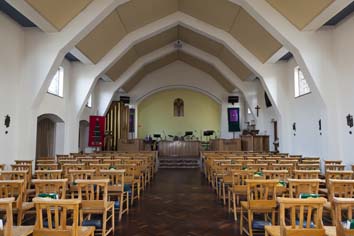Peacehaven – Ascension
Development along the cliffs between Brighton and Newhaven started in the early C20 and intensified after World War I. The area east of Telscombe Cliffs, which was actually in the parish of Piddinghoe from which it was separated by the Downs, was initially called New Anzac on Sea in honour of the Australian and New Zealand Expeditionary Force in World War I, but it soon became known as Peacehaven. Initially, most houses built on the numerous small plots were bungalows, but more substantial ones appeared later.
A temporary church was opened in 1929 (VCH 7 p66). Efforts to build a permanent one started before World War II, but by 1950 had met with no success. A design combining church and hall by a local man who was not an architect, W A Crossley, aroused the disapproval of Bishop Bell of Chichester. In his unpublished memoirs, J L Denman (BAL/MSS DeJ/7/4) describes being summoned by the Bishop after he had advised against this design. He also advised against one by G Haynes of East Blatchington, on the grounds that he was a local government employee. Denman himself prepared a design (ibid), but in the event, the church was entrusted to the safe though unadventurous hands of L K Hett and built in 1954-55 (TCA 3 p115) at a cost of £15,000. On completion, Peacehaven became a full parish.
Hett’s church is built of brick, with a west tower which is combined with the main entrance. This is beneath a round-headed west window, the only one on the church of this form. The long aisle windows are square-headed and the short sanctuary that projects to the east has no east window. Inside, the proportions of the nave are broad and low and its roof is the dominant feature with its prominent canted trusses. Both these are characteristic devices used by Hett and the work here recalls in particular his rather earlier St Richard, Haywards Heath, West Sussex. A north chapel was added at the east end of the nave in 1985 (church website).
Fitting
Font: Octagonal with a single quatrefoil on each side and a slender stem. It is not older than the C19, but does clearly predate the church. Its previous history is not known.
My thanks to Nick Wiseman for the photographs



